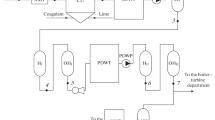Abstract
The article describes the problems of the operation of open and closed district heating systems related to the bacteriological contamination of heating-system water. It is noted that district heating systems are basically safe in sanitary epidemiological terms. Data on the dangers of sulfide contamination of heating systems are given. It is shown that the main causes of the development of sulfate-reducing and iron bacteria in heating systems are a significant biological contamination of source water to fuel heating systems, which is determined by water oxidizability, and a low velocity of the motion of heating-system water in the heating system elements. A case of sulfide contamination of a part of the outdoor heat-supply system of the city of Ulyanovsk is considered in detail. Measures for cleaning pipelines and heating system equipment from the waste products of sulfate-reducing bacteria and iron bacteria and for improving the quality of heating-system water by organizing the hydraulic and water-chemistry condition that makes it possible to avoid the bacteriological contamination of heating systems are proposed. The positive effect of sodium silicate on the prevention of sulfide contamination of heating systems is shown.
Similar content being viewed by others
References
V. I. Sharapov, “Current problems in the use of vacuum deaerators for open heat-supply systems,” Therm. Eng. 41 (8), 635 (1994).
V. I. Sharapov and O. N. Kuvshinov, “Environmental safety of open heat supply systems comprising vacuum makeup water deaerators,” Elektr. Stn., No. 2, 16–20 (1997).
“SanPiN (Sanitary Code) 2.1.4.2496-09: Drinking water. Hygienic requirements for the quality of water in centralized potable water supply systems. Quality control. Hygienic requirements for ensuring safety of hot water supply systems. An amendment to SanPiN 2.1.4.1074-01, Ross. Gazeta, No. 4916, May 22 (2009).
G. Booth, “Sulfur bacteria in relation to corrosion,” J. Appl. Bacteriol. 27, 147–181 (1964).
A. A. Griban’kova, M. A. Myamina, and S. M. Beloglazov, “Microbiological corrosion of mild steel in water–salt media containing sulfate-reducing bacteria,” Vestn. Kant Balt. Federal Univ., No. 7, 23–29 (2011).
T. A. Krasnokutskaya, K. Yu. Kudyukov, D. P. Ryabchenko, and B. N. Shukailo, “Disinfecting and monitoring the state of equipment used at heat supplying enterprises,” Novosti Teplosnab., No. 3, 42–45 (2009).
MUK (Methodical Guidelines) 4.2.1018-01: Sanitary–Microbiological Analysis of Drinking Water (Minzdrav Rossii, Moscow, 2001).
E. Ya. Sokolov, District Heating Cogeneration and Heat Networks (Energoizdat, Moscow, 1982) [in Russian].
Operational Regulations for Power Plants and Electric Networks in the Russian Federation (ENAS, Moscow, 2006) [in Russian].
RD (Guiding Document) 34-20.145-92: Methodical Guidelines on Selecting the Type of a Heat Supply System Taking Water Quality into Account. Approved by the RF Ministry for Fuel and Power on September 28, 1992 [in Russian].
MU (Methodical Guidelines) 34-70-045-83: Methodical Guidelines on Silicate Treatment of Makeup Water for the Network Path at CHPs (SPO Soyuztekhenergo, Moscow, 1983) [in Russian].
F. Widdel and N. Pfening, “Studies on dissimilatory sulfatereducing bacteria that decompose fatty acids II. Incomplete oxidation of propionate by desulfobulbus propionics gen. nov. sp. nov.,” Arch. Microbiology 131, 360–365 (1982).
J. R. Postgate and L. L. Campbell, “Classification of Desulfovibrio species the now sporulating sulfatereducing bacteria,” Bacteriol. Revs. 30 (4), 728–738 (1966).
Author information
Authors and Affiliations
Corresponding author
Additional information
Original Russian Text © V.I. Sharapov, M.M. Zamaleev, 2015, published in Teploenergetika.
Rights and permissions
About this article
Cite this article
Sharapov, V.I., Zamaleev, M.M. Solution to problems of bacterial impurity of heating systems. Therm. Eng. 62, 687–690 (2015). https://doi.org/10.1134/S0040601515060099
Published:
Issue Date:
DOI: https://doi.org/10.1134/S0040601515060099




